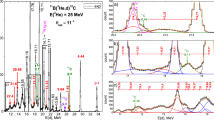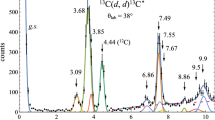Abstract.
Two-proton decay of the unbound \( T_{z} =-2\) nucleus 16Ne , produced in one-neutron knockout from a 500 MeV/u 17Ne beam, has been studied at GSI. The ground state, at a resonance energy 1.388(15) MeV, ( \( \Gamma =0.082(15)\) MeV) above the 14O +p+p threshold, and two narrow resonances at \( E_{r} =3.220(46)\) MeV and 7.57(6) MeV have been investigated. A comparison of the energy difference between the first excited 2+ state and the 0+ ground state in 16Ne with its mirror nucleus 16C reveals a small Thomas-Ehrman shift (TES) of \( +70(46)\) keV. A trend of the TES for the T = 2 quintet is obtained by completing the known data with a prediction for 16F obtained from an IMME analysis. The decay mechanisms of the observed three resonances were revealed from an analysis of the energy and angular correlations of the 14O +p+p decay products. The ground state decay can be considered as a genuine three-body (democratic) mode and the excited states decay sequentially via states in the intermediate nucleus 15F , the 3.22 MeV state predominantly via the 15F ground-state resonance, while the 7.57 MeV state decays via the 5/2+ resonance in 15F at 2.8 MeV above the 14O +p+p threshold. Further, from an analysis of angular correlations, the spin-parity of the 7.57 MeV state has been determined as \( I^{\pi} =2^{+}\) and assigned as the third 2+ state in 16Ne based on a comparison with 16C.
Similar content being viewed by others
References
F. Wamers et al., Phys. Rev. Lett. 112, 132502 (2014)
R.J. Holt et al., Phys. Lett. B 68, 55 (1977)
G.R. Burleson et al., Phys. Rev. C 22, 1180 (1980)
K. Föhl et al., Phys. Rev. Lett. 79, 3849 (1997)
G.J. KeKelis et al., Phys. Rev. C 17, 1929 (1978)
C.J. Woodward, R.E. Tribble, D.M. Tanner, Phys. Rev. C 27, 27 (1983)
I. Mukha et al., Phys. Rev. C 79, 061301 (2009)
I. Mukha et al., Phys. Rev. C 82, 054315 (2010)
K.W. Brown, arXiv:1406.3285v2 [nucl-ex] (2014).
V. Guimarães et al., Phys. Rev. 58, 117 (1998)
F. James, M. Roos, Comput. Phys. Commun. 10, 343 (1975)
L.V Grigorenko et al., Phys. Rev. Lett. 88, 042502 (2002)
M. Petri et al., Phys. Rev. C 86, 044329 (2012)
A.H. Wuosmaa et al., Phys. Rev. Lett. 105, 132501 (2010)
Y. Satou et al., Phys. Lett. B 728, 462 (2014)
K. Ogawa et al., Phys. Lett. B 464, 157 (1999)
R.G. Thomas, Phys. Rev. 88, 1109 (1952)
J.B. Ehrman, Phys. Rev. 81, 412 (1951)
H.T. Fortune, Phys. Lett. B 718, 1342 (2013)
E. Comay, I. Kelson, A. Zidon, Phys. Lett. B 210, 31 (1988)
S. Aoyama, Phys. Rev. C 62, 034305 (2000)
E. Garrido, D.V. Fedorov, A.S. Jensen, Phys. Rev. C 69, 024002 (2004)
F.C. Barker, Phys. Rev. C 59, 535 (1999)
D.F. Geesaman et al., Phys. Rev. C 15, 1835 (1977)
L.V. Grigorenko, M.V. Zhukov, Phys. Rev. C 68, 054005 (2003)
V.Z. Goldberg et al., Phys. Rev. C 69, 031302 (2004)
A. Lepine-Szily et al., Nucl. Phys. A 734, 331 (2004)
F.Q. Guo et al., Phys. Rev. C 72, 034312 (2005)
R.I. Jibuti, N.B. Krupennikova, V.Yu. Tomchinsky, Nucl. Phys. A 276, 421 (1977)
N.K. Timofeyuk, P. Descouvemont, Phys. Rev. C 81, 051301 (2010)
H.T. Fortune, R. Sherr, Phys. Rev. C 87, 057308 (2013)
A. Negret et al., Phys. Rev. C 71, 047303 (2005)
H.T. Fortune, R. Sherr, Phys. Rev. C 82, 027310 (2010)
M. MacCormik, G. Audi, Nucl. Phys. A 925, 61 (2014) 925
Y.H. Lam et al., At. Nucl. Data Tables 99, 680 (2013)
M. Wang et al., Chin. Phys. C 36, 1603 (2012)
D.R. Tilley, H.R. Weller, C.M. Cheves, Nucl. Phys. A 564, 1 (1993)
H.T. Fortune, Phys. Rev. C 74, 054310 (2006)
Author information
Authors and Affiliations
Additional information
Communicated by P. Woods
Rights and permissions
About this article
Cite this article
Marganiec, J., Wamers, F., Aksouh, F. et al. Studies of continuum states in 16 Ne using three-body correlation techniques. Eur. Phys. J. A 51, 9 (2015). https://doi.org/10.1140/epja/i2015-15009-0
Received:
Revised:
Accepted:
Published:
DOI: https://doi.org/10.1140/epja/i2015-15009-0




